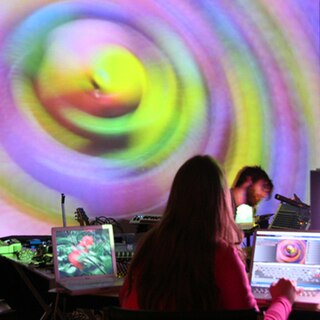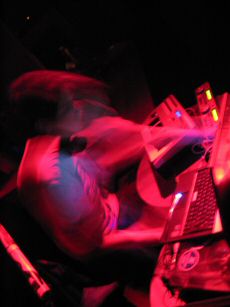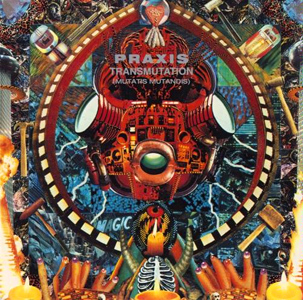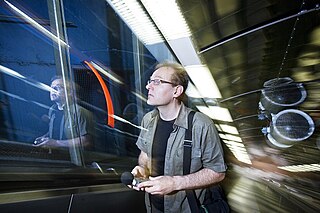Related Research Articles

Ambient music is a genre of music that emphasizes tone and atmosphere over traditional musical structure or rhythm. It is often "peaceful" sounding and lacks composition, beat, and/or structured melody. It uses textural layers of sound that can reward both passive and active listening and encourage a sense of calm or contemplation. The genre is said to evoke an "atmospheric", "visual", or "unobtrusive" quality. Nature soundscapes may be included, and the sounds of acoustic instruments such as the piano, strings and flute may be emulated through a synthesizer.

Echoes is a daily two-hour music radio program hosted by John Diliberto featuring a soundscape of ambient, space, electronica, and new-age music. The program features in-depth artist interviews and intimate "living room" performances. Interview subjects have included Brian Eno, Peter Gabriel, Laurie Anderson, and Philip Glass. Live performers have included Yo-Yo Ma, Pat Metheny, Loreena McKennitt, Steve Roach, Air and many others. Echoes has produced sixteen CD collections from these and other in-studio performances. Distributed by Public Radio Exchange, Echoes is currently heard on about 80 radio stations. Echoes can also be heard on the web, with 24/7 streaming and on-demand audio available.
Robert Rich is an ambient musician and composer based in California, United States. With a discography spanning over 30 years, he has been called a figure whose sound has greatly influenced today's ambient music, New-age music, and even IDM.

Karlheinz Essl is an Austrian composer, performer, sound artist, improviser, and composition teacher.

Mark Mallman is a Minnesota musician, film composer, and memoirist. Since 1998, he has released nine full-length studio albums, Happiness (2021) being his most recent.

Field recording is the term used for an audio recording produced outside a recording studio, and the term applies to recordings of both natural and human-produced sounds. It also applies to sound recordings like electromagnetic fields or vibrations using different microphones like a passive magnetic antenna for electromagnetic recordings or contact microphones. For underwater field recordings, a field recordist uses hydrophones to capture the sounds and/or movements of whales, or other aquatic organisms. These recordings are very useful for sound designers.
Pimmon is the recording name of Australian electronic and ambient musician, record producer and arranger, Paul David Gough. He has released records on labels such as Fat Cat Records, Fällt, Tigerbeat6, Staalplaat and Staubgold, and collaborated with Keith Rowe and Oren Ambarchi, among others.
Byzar is an American experimental electronic music ensemble, considered one of the founders of the Illbient genre, along with DJ Spooky, Sub Dub, We, and the Soundlab collective, active in the New York experimental dance/electronic music scene during the 1990s.

VJing is a broad designation for realtime visual performance. Characteristics of VJing are the creation or manipulation of imagery in realtime through technological mediation and for an audience, in synchronization to music. VJing often takes place at events such as concerts, nightclubs, music festivals and sometimes in combination with other performative arts. This results in a live multimedia performance that can include music, actors and dancers. The term VJing became popular in its association with MTV's Video Jockey but its origins date back to the New York club scene of the 1970s. In both situations VJing is the manipulation or selection of visuals, the same way DJing is a selection and manipulation of audio.

Live PA is the act of performing live electronic music in settings typically associated with DJing, such as nightclubs, raves, and more recently dance music festivals.
DreamSTATE is a Canadian ambient music project known for their soundscape installations and early live ambient performances in the Toronto, Ontario area. Their soundscapes combine electronic music processes with field recordings and range from light to dark ambient and drone music.

Andrew John Preston "Andi" Spicer was an English electroacoustic classical music composer who used electronics in his compositions.
Mel Wesson is a British film, TV and video game composer and ambient music designer. He is a highly influential 'musical sound designer' in Hollywood having worked on many blockbuster films, yet his sound is often hard to describe or even identify. He is probably best known for his collaboration work with Hans Zimmer and has contributed with both ambient music design and music to some of last decades biggest Hollywood blockbusters. He has also made numerous production music CDs for Extreme Music which loosely feature some of the atmospheric textures in his world of ambient music design.

Transmutation (Mutatis Mutandis) is the first album by Bill Laswell's ever-changing "supergroup" Praxis. The album was released in 1992 and features Buckethead on guitar, Bootsy Collins on bass and vocals, Brain on drums, Bernie Worrell on keyboards and DJ AF Next Man Flip on turntables.
Biomusic is a form of experimental music which deals with sounds created or performed by non-humans. The definition is also sometimes extended to include sounds made by humans in a directly biological way. For instance, music that is created by the brain waves of the composer can also be called biomusic as can music created by the human body without the use of tools or instruments that are not part of the body.

Brian Wayne Transeau, known by his initials as BT, is an American musician, DJ, singer, songwriter, record producer, composer, and audio engineer. An artist in the electronic music genre, he is credited as a pioneer of the trance and intelligent dance music styles that paved the way for EDM, and for "stretching electronic music to its technical breaking point." In 2010, he was nominated for a Grammy Award for Best Electronic/Dance Album for These Hopeful Machines. He creates music within myriad styles, such as classical, film composition, and bass music.

Machinefabriek is the musical nom de plume of Dutch musician/sound artist and graphic designer Rutger Zuydervelt.

Petri Kuljuntausta is a Finnish composer, musician, sound artist and author of three books on electronic music and sound art. Since the 1990s he has belonged to a new generation of composers in Finland interested in experimental and electronic music.
Bruce Alexander Gibson IV is an American record producer, engineer, mixer, composer, and brand developer. He has been a part of production teams that in total, have sold over 25 million albums worldwide and has worked with Van Halen, David Lee Roth, Rod Stewart, Ringo Starr, Jane’s Addiction, Rockabye Baby!, Apple, Paramount, VH1, HBO, and Showtime.

Sleep Party People is the alias of musician Brian Batz, hailing from Denmark.
References
- 1 2 3 4 Swensson, Andrea (2012-08-20). "Mark Mallman planning cross-continental, 7-day-long Marathon 4 | Local Current Blog | The Current from Minnesota Public Radio". Blog.thecurrent.org. Retrieved 2016-07-24.
- ↑ Debra Black (2012-09-20). "Performance artist Mark Mallman tours U.S. on marathon music-making journey | Toronto Star". Thestar.com. Retrieved 2016-07-24.
- 1 2 3 "Road-Tripping Rocker to Livestream Brain Wave Music While He Sleeps". Wired.com. 2012-09-13. Retrieved 2016-07-24.
- 1 2 Erik Hess (2012-08-28). "Mark Mallman preps for Marathon 4, a week-long NYC to LA song". City Pages. Retrieved 2016-07-24.